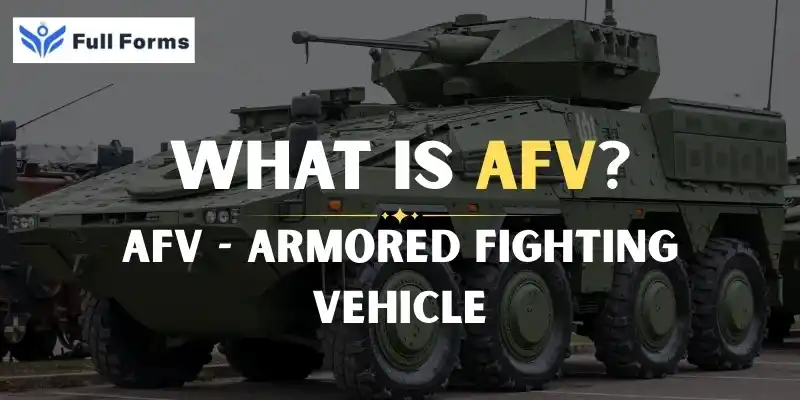Armored Fighting Vehicle
(AFV)

Description
Armored Fighting Vehicle: The Key to Moving and Staying Safe on the Battlefield Today
In the modern world, battles are always changing because of new technology and ideas. Armored Fighting Vehicles (AFV) are heavily protected and armed vehicles that are designed to dominate the battlefield by combining firepower, mobility, and protection. They are one of the most important parts of ground combat. These vehicles have played a big part in changing how the military fights and have been very important for keeping soldiers alive in a wide range of dangerous situations.
What Is an Armored Fighting Vehicle?
Simply put, an Armored Fighting Vehicle is a military vehicle. Its armor plating protects against small arms fire and various dangers of the battlefield. Whereas standard trucks or transport vehicles are designed only as adjuncts to fighting, AFVs are designed for direct participation in battle. They carry an assortment of arms— from machine guns to powerful cannons— on the move integral components of both offense and defense.
Core Purpose of AFVs
The basic mission of AFVs is to enable troops maneuvering on a deadly battlefield with reduced risk of getting wounded or killed. Since they are capable of delivering speed, protection, and firepower at the same time, these vehicles serve as mobile fortresses that could be used in different battlefield scenarios — from conducting tank battles in open fields to fighting inside the built-up areas within limited spaces.
Types of Armored Fighting Vehicles
The AFV family is broad. It comprises several types that fall within its ranks, each designed toward some particular battlefield role. Some of the most common include Main Battle Tanks (MBTs). These are the heavy hitters of the battlefield, typically equipped with large-caliber cannons and describing thick armor. In most cases, tanks are built to break through enemy defenses while taking direct hits.
Infantry Fighting Vehicles are armored carriers that take infantrymen right to the front lines while raining down covering fire. And, unlike mere personnel carriers, these brutes carry hefty autocannons and sometimes even anti-tank missiles.
Armored Personnel Carriers are more about getting the boys to the fight in one piece than mixing it up on the front lines. Protection plus enough firepower to make sure the soldiers inside step out ready for battle.
Recon vehicles- light armor, fast, stealthy. Info on enemy spots without getting caught. Every AFV type fits a different tactical use but they all have protection, mobility, and firepower.
Evolution of AFVs in Warfare
The idea of armored fighting vehicles came about in World War I. It was then that the first tanks were created to break the deadlock of trench warfare. Since that time, AFVs have experienced a great deal of technological growth. Present-day AFVs contain advanced targeting apparatus, armor that reacts to defeat missiles and other means of communication support on the move during a battle.
The evolution of AFVs reflects the warfare — from static trench battles to fast-paced, mechanized warfare. In modern times, AFVs allow armies to maneuver rapidly with firepower that can be devastating while offering protection to the crew under adverse combat conditions.
Advantages of Armored Fighting Vehicles
The armored fighting vehicles can give much strength and force. Just a small number of well-prepared soldiers in AFVs can do what would usually need a big group of infantry forces.
Thick armored protection of an AFV against small arms fire, landmines, and explosive devices will give the soldiers confidence to operate in high-risk zones. They can stay where they are attacking from with accurate and powerful fire support mounted on the vehicle.
In the fighting of cities, armored cars could cover the foot soldiers as they clean houses and roads so these machines are very useful for today’s rebels’ fights and missions of keeping peace.
Limitations and Challenges
Much as they are powerful, AFVs have nothing close to being described as all-rounders. Their weight and size practically reduce mobility when in such terrains as dense forests, swamps, or mountainous areas. They need logistics to the magnitude of fuel, maintenance, and special crews to sustain their operation.
A further challenge includes the growing threat posed by modern anti-tank weapons and improvised explosive devices. The more effective means adversaries develop accurate ways to counter AFVs, military engineers respond by developing new armor designs and defensive systems to retain the advantage on the battlefield.
The Future of Armored Fighting Vehicles
In the days to come, the fortunes of AFVs will be directly linked with Artificial Intelligence, Robotics, and Material Science. Autonomous or remotely operated AFVs can minimize exposure of human soldiers in reconnaissance or direct combat operations. Lightweight but stronger armor materials will enhance mobility while maintaining the same level of protection.
Also, these vehicles will give an opportunity for integration into network-centric warfare systems that are more conscious about battlefield environments, supporting even faster decision instances and coordinated strikes involving different types of vehicles and infantry units.
Conclusion
Protection, mobility, and firepower have made the Armored Fighting Vehicle a very formidable platform and kept it as a centerpiece in modern warfare. Its great ability of survivability in various types of environments gives it good offensive and defensive capabilities which make these vehicles very indispensable on today’s battlefields. There will be challenges, but innovation assures AFVs that they will constantly evolve to meet the challenges of future warfare to keep soldiers safe while maintaining the lead in ground combat.
